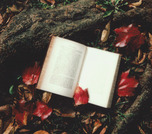
A guide to support comparing and contrasting characters across stories.
- Subject:
- Arts and Humanities
- Literature
- Material Type:
- Activity/Lab
- Date Added:
- 10/12/2021

A guide to support comparing and contrasting characters across stories.
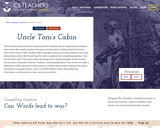
This seventh grade annotated inquiry provides students with an opportunity to explore how words affect public opinion through an examination of Harriet Beecher Stowe’s novel Uncle Tom’s Cabin. Students will investigate historical sources related to the novel and reactions in the North and South in order to address the compelling question, “Can words lead to war?” This query takes advantage of the mixed messages students often receive about the power of words. Students’ understanding about how words can make a difference is often grounded in discussions of words used to bully, instead of the power of words to encourage reform. This is an ANNOTATED inquiry with additional information on the questions, tasks, and sources within.

Explore how production choices can contribute to characterization and provide a deeper understanding of how that character sees the world in this video from Great Performances: Romeo and Juliet. The National Theater's production creates a modern stripped-down version of the play that utilizes both staged theater and film techniques to tell the story of the iconic star-crossed lovers. Students will analyze these techniques and how they help reveal the essence of Juliet's character.

The subtitle of this course for the spring 2003 term is “American Television: A Cultural History.” The class takes a cultural approach to television’s evolution as a technology and system of representation, considering television as a system of storytelling and myth-making, and as a cultural practice, studied from anthropological, literary, and cinematic perspectives. The course focuses on prime-time commercial broadcasting, the medium’s technological and economic history, and theoretical perspectives. There is much required viewing as well as readings in media theory and cultural interpretation.
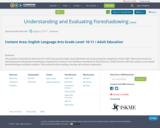
This module is intended for adult learners with some previous high school education who are pursuing the completion of their GED. This lesson focuses on identifying and evaluating foreshadowing, targeting the Common Core Readiness Standards for ELA/Literacy 2. Adult learners will read, analyze, and evaluate foreshadowing in multiple examples. This module involves reading, viewing, and writing components.
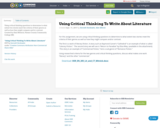
Using critical thinking questions to determine to what extent two stories meet the criteria of their genres as well as how they might compare and/or contrast.
Created by Alan Mitnick, Passaic County Community College (NJ)
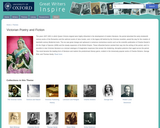
This collection of Victorian Poetry and Fiction on the Great Writers Inspire site includes a selection of writers we feel to be particularly inspiring in an age dominated by authors and literature. It includes audio and video lectures and short talks, downloadable electronic texts and eBooks, and background contextual resources curated by specialists at the University of Oxford. This landing page allows users to explore topics such as The Victorian Gothic, Victorian Publishing History, Literature and Religion as well as majors authors.

Writing in the wake of the Civil War, poet Walt Whitman insisted that “the real war will never get in the books.” Throughout American history, the experience of war has fundamentally shaped the ways that Americans think about themselves, their fellow Americans, and the meanings of national citizenship. War has also posed challenges of representation, both for those who fought as well as those who did not. This subject examines how Americans have told the stories of modern war in history, literature, and popular culture, and interprets them in terms of changing ideas about American national identity.
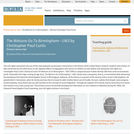
This collection uses primary sources to explore The Watsons Go To Birmingham1963 by Christopher Paul Curtis. Digital Public Library of America Primary Source Sets are designed to help students develop their critical thinking skills and draw diverse material from libraries, archives, and museums across the United States. Each set includes an overview, ten to fifteen primary sources, links to related resources, and a teaching guide. These sets were created and reviewed by the teachers on the DPLA's Education Advisory Committee.
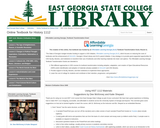
Lesson 1: The Age of Enlightenment, Reason & Scientific Revolution
Lesson 2: Changes in Political Thought: Imperialism, Colonialism, Nationalism, & Revolution
Lesson 3: Cultural Life, 1700-1900 - Arts, Music, Literature, & Religion
Lesson 4: The World Outside the West
Lesson 5: Industrialization & Lived Experiences
Lesson 6:The World in Two Wars
Lesson 7: Post-Colonial World Culture & Globalization
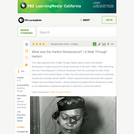
Professor Kate Rushin describes the Harlem Renaissance as a large social and cultural movement fueled by many factors in this video from A Walk Through Harlem.

Students will watch a video of a storyteller coming up with a rap that tells a story. They will identify story elements (who, what, and where), and record significant details. The next lesson plan ,Using Story Elements to Write a Rap, has students creating their own rap with the story elements.
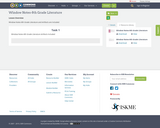
Window Notes-8th Grade Literature and Artifacts are Included
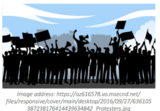
Civil rights activist, Coretta Scott King, once said, “Freedom is never really won, you earn it and win it in every generation.” The signing of the Civil Rights Act of 1964 was a win, but it did not mark the end of the movement. This lesson will examine the numerous groups that are still fighting for civil rights today, including African Americans, Muslims, women, and members of the LGBTQ community. This lesson will provide you the opportunity to check your “privilege” and compare it with the groups who are fighting for equal rights to this day. You will be encouraged to keep an open mind while learning about each group and to listen with understanding and empathy.StandardsCC.8.5.9-10.D Determine the meaning of words and phrases as they are used in a text, including vocabulary describing political, social, or economic aspects of history/social science.CC.8.6.9-10.G Gather relevant information from multiple authoritative print and digital sources, using advanced searches effectively; assess the usefulness of each source in answering the research question; integrate information into the text selectively to maintain the flow of ideas, avoiding plagiarism and following a standard format for citation.5.1.12.C Evaluate the application of the principles and ideals in contemporary civic life.Liberty / FreedomDemocracyJusticeEquality

This pass/fail seminar should be a fun setting where we can all enjoy a love of good books together. Students will read approximately one novel every two weeks, and the class will discuss each novel in a relaxed and interactive setting, with attention to whatever themes and issues interest them most about each book. We will read a wide mixture of classic and contemporary novels written by women, including: Edith Wharton, The House of Mirth; Toni Morrison, Jazz; Virginia Woolf, Mrs. Dalloway; Alice Walker, The Color Purple; Charlotte Brontë, Jane Eyre; Sheri Reynolds, The Rapture of Canaan; Jane Austen, Pride and Prejudice; and Sylvia Plath, The Bell Jar. Recurrent issues likely to be discussed include: gender, race, and class; romance, love, and marriage; depression and suicide; and conception, childbirth, and parenthood.
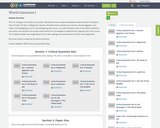
This is a redesign of an online course (ENG 140) with all course materials available online and free for students. Texts include: The Epic of Gilgamesh, Genesis, the Book of Job, Analects by Confucius, Ancient Egyptian Love Poetry, the Daodejing by Lao-tzu. By redesigning the course, I can select literature from more diverse traditions and culture and include more unique works which are not available in textbook that I typically use in this course. This module includes new assignments for the new readings and assessments for these new assignments.All course content created by Kerrianne Gamache. Content added to OER Commons by Jordana Shaw
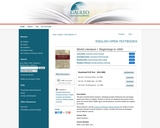
This peer-reviewed World Literature I anthology includes introductory text and images before each series of readings. Sections of the text are divided by time period in three parts: the Ancient World, Middle Ages, and Renaissance, and then divided into chapters by location.

This semester, we will read writing about travel and place from Columbus’s Diario through the present. Travel writing has some special features that will shape both the content and the work for this subject: reflecting the point of view, narrative choices, and style of individuals, it also responds to the pressures of a real world only marginally under their control. Whether the traveler is a curious tourist, the leader of a national expedition, or a starving, half-naked survivor, the encounter with place shapes what travel writing can be. Accordingly, we will pay attention not only to narrative texts but to maps, objects, archives, and facts of various kinds.
Our materials are organized around three regions: North America, Africa and the Atlantic world, the Arctic and Antarctic. The historical scope of these readings will allow us to know something not only about the experiences and writing strategies of individual travelers, but about the progressive integration of these regions into global economic, political, and knowledge systems. Whether we are looking at the production of an Inuit film for global audiences, or the mapping of a route across the North American continent by water, these materials do more than simply record or narrate experiences and territories: they also participate in shaping the world and what it means to us.
Authors will include Olaudah Equiano, Caryl Philips, Claude Lévi-Strauss, Joseph Conrad, Jamaica Kincaid, William Least Heat Moon, Louise Erdrich, Álvar Núñez Cabeza de Vaca.
Expeditions will include those of Lewis and Clark (North America), Henry Morton Stanley (Africa), Ernest Shackleton and Robert F. Scott (Antarctica).

In this course we will read essays, novels, memoirs, and graphic texts, and view documentary and experimental films and videos which explore race from the standpoint of the multiracial. Examining the varied work of multiracial authors and filmmakers such as Danzy Senna, Ruth Ozeki, Kip Fulbeck, James McBride and others, we will focus not on how multiracial people are seen or imagined by the dominant culture, but instead on how they represent themselves. How do these authors approach issues of family, community, nation, language and history? What can their work tell us about the complex interconnections between race, gender, class, sexuality, and citizenship? Is there a relationship between their experiences of multiraciality and a willingness to experiment with form and genre? In addressing these and other questions, we will endeavor to think and write more critically and creatively about race as a social category and a lived experience.

This course focuses on the period between roughly 1550-1850. American ideas of race had taken on a certain shape by the middle of the nineteenth century, consolidated by legislation, economics, and the institution of chattel slavery. But both race and identity meant very different things three hundred years earlier, both in their dictionary definitions and in their social consequences. How did people constitute their identities in early America, and how did they speak about these identities? Texts will include travel writing, captivity narratives, orations, letters, and poems, by Native American, English, Anglo-American, African, and Afro-American writers.